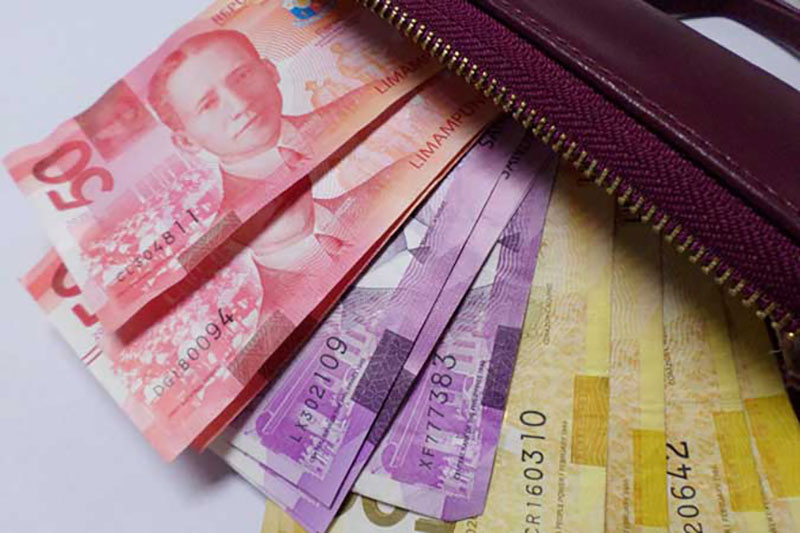
Upgrade to High-Speed Internet for only ₱1499/month!
Enjoy up to 100 Mbps fiber broadband, perfect for browsing, streaming, and gaming.
Visit Suniway.ph to learn
 BW FILE PHOTO
BW FILE PHOTOTHE PESO sank to a three-week low against the dollar on Wednesday as the market remained worried over the potential economic impact of the Trump administration’s plan to impose reciprocal tariffs starting next week.
The local unit closed at P57.69 per dollar on Wednesday, weakening by nine centavos from its P57.60 finish on Tuesday, Bankers Association of the Philippines data showed.
This was the peso’s worst finish in over three weeks or since it ended at P57.753 on March 4.
The peso opened Wednesday’s session a tad stronger at P57.58 against the dollar. It dropped to as low as P57.74 intraday, while its best showing was at P57.57 versus the greenback.
Dollars exchanged declined to $1.34 billion from $1.54 billion on Tuesday.
“The dollar-peso closed lower on risk-off sentiment and due to momentum from yesterday’s announcement by the Bangko Sentral ng Pilipinas (BSP) on a possible rate cut in April,” a trader said in a text message, noting that this could result in a narrower rate differential with the US Federal Reserve.
The US dollar was slightly higher on Wednesday as nervy traders awaited clarity on President Donald J. Trump’s trade policy ahead of a new round of tariffs next week, Reuters reported.
Traders clung on to hopes of flexibility from the White House after Mr. Trump said on Monday that not all trade levies would come on the April 2 deadline, and some countries would get breaks, without providing further details.
At the same time, Mr. Trump opened a new front in his trade war with a directive for 25% secondary tariffs on any country that buys oil or gas from Venezuela. In turn, oil prices rose, although the impact was offset by relief from Black Sea maritime security deals struck by the US in the war in Ukraine.
The US dollar index, which measures the currency against a basket of six major peers, inched higher after slipping 0.1% on Tuesday, its first losing session in about a week.
The index plumbed a five-month low last week, weighed down by worries that Mr. Trump’s trade war could trigger a US recession. Data overnight showed consumer confidence plunged to the lowest level in more than four years this month.
Meanwhile, BSP Governor Eli M. Remolona, Jr. said in an interview with Bloomberg Television on the sidelines of the HSBC Global Investment Summit in Hong Kong on Tuesday that there is a “good chance” that the Monetary Board will cut rates by 25 basis points (bps) at their April 10 meeting, Bloomberg reported.
Mr. Remolona said the BSP remains on an easing cycle and could bring down borrowing costs by as much as 75 bps this year depending on data.
The central bank has reduced benchmark interest rates by a cumulative 75 bps since it began its rate-cut cycle in August last year, with its policy rate currently at 5.75%.
For its part, the US central bank last week reiterated its cautious policy stance, with Fed Chair Jerome H. Powell signaling that they are in no rush to cut rates.
The US central bank left interest rates unchanged last week, though policy makers indicated they expected to reduce borrowing costs twice this year.
Rizal Commercial Banking Corp. Chief Economist Michael L. Ricafort said in a Viber message that the peso could have been dragged down by the rupiah reaching near all-time lows.
The rupiah was flat at 16,580 per US dollar at 0645 GMT, hovering near the all-time low of 16,800 touched in June 1998, during the Asian Financial Crisis and just after the fall of Indonesia’s authoritarian leader, General Suharto, Reuters reported.
On Tuesday, the rupiah hit a post-crisis low of 16,640, before the central bank intervened to defend the currency.
For Thursday, the trader expects the peso to move between P57.50 and P57.80 per dollar, while Mr. Ricafort sees it ranging from P57.60 to P57.80. — A.M.C. Sy with Reuters




